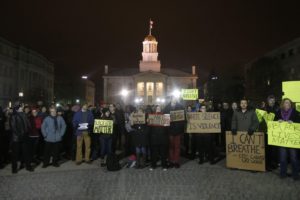One of the best things about working in the media is the access it provides to all facets of the community. When combined with innate curiosity and a penchant for organizing, this access results in piles of string — journalism shorthand for scraps of information that don’t warrant their own report, but that could possibly be valuable in the future.
Since I’m curious about barriers to civic participation — not only why this person doesn’t participate, but why this neighborhood tends not to participate — I collect string on how groups interact.
Some pieces are incredibly benign. For instance, a woman told me that she and her husband alternated attending meetings to save on child care.
Others, however, provide glimpses of how infrastructure availability is determining civic and social participation.
The most glaring example was during a Cedar Rapids meeting several years ago. Organizers hoped a diverse group could discuss issues surrounding a spat of neighborhood incidents and search for solutions. One woman arrived late, because city bus service is not available at night. Even if the buses had been running, she said, the meeting location was not on a route.

At a time and place convenient to them, organizers had gathered under the premise of working together, and later bemoaned a lack of participation by others they’d systemically, if inadvertently, excluded.
While the issues around that specific gathering make it memorable, meetings are held everyday to discuss steps forward or to build policies that aren’t easily accessible.
Do I mean to imply that every meeting can be attended by all affected parties? No, but I do contend that public accessibility has taken a back seat to convenience.
City council meetings held in neighborhood settings are an oddity, something unusual enough to warrant additional news coverage. Likewise when school boards choose to hold “remote” meetings within their neighborhood schools.
Technology has bridged some gaps, allowing some to watch meetings on cable channels or via the Internet. But watching a meeting is hardly the same as being a part of it.
There are many lessons to be learned in the wake of recent national demonstrations, and I believe one of the biggest is that people need and want to be included. They want to be present, participate in shaping local policies and have a voice in the process.
The public bears the burden of choosing to attend and participate, and this is especially true during mundane moments of planning. Being present only in times of turmoil is no longer an acceptable, much less workable practice.
But government boards and commissions, civic and service clubs also should acknowledge the world has changed. School administration buildings are no longer built within walking distance of the neighborhoods they serve. Government meetings need not be limited to Des Moines or city and county facilities where only a single perspective is heard.
Taking the conversation to the people has been relegated to upcoming bond issues, redistricting or controversial policy changes. Sustainable, diverse communities require such connections be regularly fostered and nurtured.
This column by Lynda Waddington originally published on Dec. 6, 2014. Photo credit: Sy Bean/The Gazette
